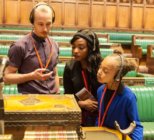The Mendoza Review refers to entrepreneur, publisher and philanthropist, Neil Mendoza, who is a non-executive board member of the DCMS and was the lead independent reviewer in the report. He was supported by officials at DCMS and engaged closely with the museums sector, ACE, HLF and Historic England.
This Review proposes a series of recommendations to enable a more strategic approach to the application of public funding in museums by government and its ALBs [Arms Length Bodies]. I strongly believe that if these recommendations are implemented in full, it will make a great and positive difference to museums in England
The review looked at what the national infrastructure for museums is, what it could and should be, the museums sponsored directly by government, and the challenges and opportunities for all of England’s museums. The review found that England’s museum sector currently employs around 33,000 people and while the review focuses primarily on the 1,312 ACE accredited museums, it does consider the wider context of the sector, which encompasses approximately 2,000 museums in England. The review does not cover the policy of free admission to the permanent collections of national museums as this is it says that this is a manifesto commitment. The review also consulted with museums in Scotland, Wales and Northern Ireland.
“In this Review we have described the museum sector and tried to come to an understanding of the various ways the government steers, funds, and influences it,” says Mendoza in the review’s introduction. “We have also established what we feel to be the priorities and outcomes that government and museums want. This Review proposes a series of recommendations to enable a more strategic approach to the application of public funding in museums by government and its ALBs. I strongly believe that if these recommendations are implemented in full, it will make a great and positive difference to museums in England.”
The Mendoza Review proposes recommendations enabling a more strategic approach to public funding for museums from government and its Arm’s Length Bodies (ALBs). It highlights the increased importance for government and its ALBs (including the National Lottery) of distributing funding in a more joined-up and effective fashion.
The roles and responsibilities for relevant stakeholders are divided as follows:
A more strategic and focused approach by DCMS and its ALBs;
A more prominent and assertive role for Arts Council England;
A more strategic use of Lottery funding for museums;
A more active role for Historic England; and national responsibilities for national museums.
The report also lists the different ways the Government funds museums and says for the first time it has identified and quantified as many of those funding streams as possible.
For example:
- through the direct sponsorship of national museums by DCMS;
- by ACE;
- via the Department of Communities and Local Government (DCLG) to the local authorities that fund museums;
- from the Department for Education (DfE) via The Higher Education Funding Council for England (HEFCE) and universities;
- via the Ministry of Defence (MoD) to military museums;
- via Her Majesty’s Revenue and Customs (HMRC) in tax reliefs and Her Majesty’s Treasury (HMT) by grant.
- The DCMS is also responsible for the HLF and Historic England
“The numbers help to express the entirety of how government helps to fund England’s museums,” says Mendoza. “I do not believe that this calculation has been done before. For example, we estimate that the government provided total funding of approximately £844m in 2016/2017. It is unlikely that there will be significant additional money available for the sector in the immediate future. The main thrust of our recommendations is, therefore, to ensure that we use existing funding in the best way possible.”
The review notes that over the past ten years, although nominally maintained, funding overall has reduced by 13 per cent in real terms and recommends museums do need to increase and diversify their income further.
This falls under one of the nine categories for recommendations in the review, which are:
1.Adapting to today’s funding environment
2.Growing and diversifying audiences
3.Dynamic collection curation and management
4.Contributing to placemaking and local priorities
5.Delivering cultural education. Working in museums
6.Developing leaders with appropriate skills
7.Diversifying the workforce
8.Digital capacity and innovation
9.Working internationally
The Review also sets out ideas for local authorities on how to make best use of their museums, and best practice suggestions for the sector itself.
John Glen, Minister for Arts, Heritage and Tourism, said the Government accepts the report’s recommendations and will begin work to prioritise and make them a reality. “They are a sensible set of ideas, particularly within the current financial circumstances and in light of Britain’s exit from the European Union, designed to streamline and improve how Government and its Arm’s-Length Bodies operates with, for, and towards the museums sector – helping them to remain ‘jewels in our national crown’.”
Support Museums
He also said that there is no room for complacency and that there are changing audience expectations, a greater need for museums as spaces of personal and community reflection and exploration, and opportunities in digital technology that need to be seized. “We want to see museums that are strong and valued parts of people’s lives, whose staff and visitors are diverse, and that protect, research, and share their collections. And we want to support museums to be at the centre of civic and economic development, helping our towns and cities succeed and individuals to live healthy and happy lives.”
The review’s recommendations are already being tackled in one way or another by museums across England but Glen noted that it would create a solid foundation for how the Government will do a better job at putting in place the conditions museums need to serve their audiences, care for collections and have sustainable futures as key factors in the local communities and economies.
The Government also published today a Strategic Review of DCMS-sponsored museums alongside the Mendoza Review. It says this is the first clustered review undertaken by any government department, following Cabinet Office guidelines for tailored reviews. It examines the form and functions of 16 ALBs (15 museums and the British Library) sponsored by DCMS, their functions, forms, effectiveness, efficiency and accountability.
“Of particular importance was establishing the extent of the leadership and coordinating activity these ALBs provide, nationally and internationally, identifying any areas for improvement,” the DCMS stated. “It should be read alongside the Mendoza review for a full picture of the role, importance and significance of the sponsored museums, especially after the UK’s exit from the European Union, and how the findings from this review feed into and support its recommendations.”











